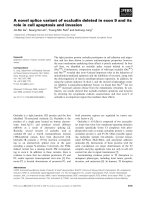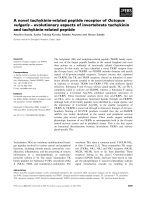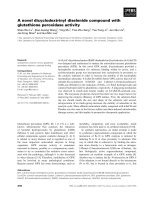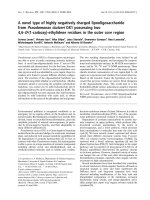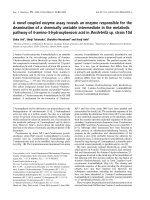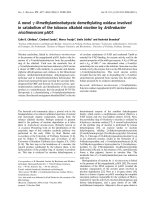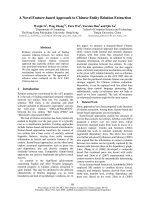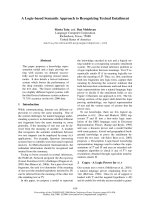Báo cáo khoa học: A novel mass spectrometric approach to the analysis of hormonal peptides in extracts of mouse pancreatic islets ppt
Bạn đang xem bản rút gọn của tài liệu. Xem và tải ngay bản đầy đủ của tài liệu tại đây (356.1 KB, 7 trang )
A novel mass spectrometric approach to the analysis of hormonal
peptides in extracts of mouse pancreatic islets
Margareta Ramstro¨m
1
, Charlotte Hagman
2
, Youri O. Tsybin
2
, Karin E. Markides
1
, Per Ha
˚
kansson
2
,
Albert Salehi
3
, Ingmar Lundquist
3
, Rolf Ha
˚
kanson
3
and Jonas Bergquist
1
1
Institute of Chemistry, Department of Analytical Chemistry,
2
Division of Ion Physics, The A
˚
ngstro
¨
m Laboratory, Uppsala University,
Sweden;
3
Department of Pharmacology, Institute of Physiological Sciences, Lund University, Sweden
Liquid chromatography mass spectrometry (LC-MS) is a
valuable tool in the analysis of proteins and peptides. The
combination of LC-MS with different fragmentation
methods provides sequence information on components in
complex mixtures. In this work, on-line packed capillary
LC electrospray ionization Fourier transform ion cyclotron
resonance MS was combined with two complementary
fragmentation techniques, i.e. nozzle-skimmer fragmenta-
tion and electron capture dissociation, for the determination
of hormonal peptides in an acid ethanol extract of mouse
pancreatic islets. The most abundant peptides, those derived
from proinsulin and proglucagon, were identified by their
masses and additional sequence-tag information established
their identities. Interestingly, the experiments demonstrated
the presence of truncated C-peptides, des-(25–29)-C-peptide
and des-(27–31)-C-peptide. These novel findings clearly
illustrate the potential usefulness of the described technique
for on-line sequencing and characterization of peptides in
tissue extracts.
Keywords: liquid chromatography; Fourier transform ion
cyclotron resonance mass spectrometry; electron capture
dissociation; pancreas; peptides.
Mass spectrometry is a rapid, sensitive and reliable method
for the analysis of complex samples. Fourier transform
ion cyclotron resonance mass spectrometry (FTICR MS)
provides the combination of high sensitivity, ultra high
resolution and mass accuracy [1,2] and has proved to be of
importance in studies of biomolecules [3].
When examining complex samples, such as body fluids
and tissue extracts, it is advantageous to use on-line separ-
ation, such as liquid chromatography (LC) [4] or capillary
electrophoresis [5], prior to MS. The separation of molecules
in time decreases the complexity of the spectra, reduces the
ion suppression in the spray and results in a preconcentra-
tion of the analytes. Several reports have described the
advantages of combining LC with electrospray ionization
(ESI) FTICR MS. For example, attomole detection limits
have been reported for peptide analysis [6]. Enzymatic
digests of proteins from prokaryotic and mammalian cells
[7–10] and of proteins in cerebrospinal fluid [11] have been
successfully analysed by the LC-FTICR MS approach.
Furthermore, the chromatographic separation of analytes
prior to MS opens up the possibility to apply on-line
fragmentation of components in complex mixtures. The
information obtained from such experiments can be used
to help identify unknown components and to characterize
post-translational modifications. Different fragmentation
methods, such as infrared multiphoton dissociation [12,13],
electron capture dissociation (ECD) [14,15], and collision
induced dissociation (CID) [13,16] have been combined with
LC-FTICR MS for the examination of peptide or protein
mixtures.
MS has proven to be of great value when analysing
endocrine peptides of biological importance [17,18]. Here
we present a novel mass spectrometric method for the
detection and identification of peptides and proteins in
tissue extracts. To illustrate the method, a sample of mouse
pancreatic islets was subjected to on-line packed capillary
LC combined with either nozzle-skimmer fragmentation or
ECD ESI FTICR MS. The rationale behind the study is
that a peptide hormone can be expected to make up a
substantial proportion of the peptides in an endocrine cell.
Insulin is the predominant and best known peptide in such
extracts. To our knowledge, the LC-ECD FTICR MS
approach has not previously been applied to the analysis of
tissue extracts.
Nozzle-skimmer fragmentation and ECD represent two
different classes of ion fragmentation techniques. In nozzle-
skimmer fragmentation, or up-front collision-induced dis-
sociation, the ions are accelerated into other molecules in
the high pressure region (2 Torr) of the mass spectrometer
by applying a high voltage between the nozzle and the
skimmer. After each collision the internal ion energy is
increased until it equals the dissociation energy of the
weakest bond and fragmentation is induced [19,20]. ECD is
so far only implemented in FTICR MS [21]. In this method,
ion fragmentation is a result of reactions with low-energy
Correspondence to J. Bergquist, Institute of Chemistry,
Department of Analytical Chemistry, Uppsala University,
PO Box599, SE-751 24 Uppsala, Sweden.
Fax: + 46 18 4713692, Tel.: + 46 18 4713675,
E-mail:
Abbreviations: ACN, acetonitrile; ECD, electron capture dissociation;
FTICR MS, Fourier transform ion cyclotron resonance mass
spectrometry; GRPP, glicentin-related pancreatic peptide;
HAc, acetic acid.
(Received 26 March 2003, revised 22 May 2003,
accepted 27 May 2003)
Eur. J. Biochem. 270, 3146–3152 (2003) Ó FEBS 2003 doi:10.1046/j.1432-1033.2003.03690.x
electrons that take place in the cell at ultra-high vacuum
(10
)10
)10
)9
Torr). The advantage of ECD compared to
other fragmentation methods is that stronger bonds can
dissociate prior to weaker bonds. At the present stage of
method development the efficiency of nozzle-skimmer
fragmentation exceeds that of ECD. By applying both
nozzle-skimmer fragmentation and ECD to the pancreatic
islet extract we expect to achieve complementary sequence
information on the peptides under study.
Materials and methods
Animals
Female mice of the NMRI strain (B & K Universal,
Sollentuna, Sweden), weighing 25–30 g were used through-
out the experiments. They were fed a standard pellet diet
and tap water ad libitum. Appropriate measures were taken
to minimize pain and discomfort for the mice, which were
maintained in accordance with the National Institutes of
Health Guide for the care and use of Laboratory Animals.
1
All experiments were approved by the regional ethical
committee
2
for animal research (Lund, Sweden).
Islet isolation and sample handling
Preparation of isolated pancreatic islets from the mouse
was performed by retrograde injection of a collagenase
solution via the bile-pancreatic duct [22]. Islets were col-
lected by hand-picking under a stereomicroscope at room
temperature as previously described [23]. After wash-
ing, 2000–2200 islets (approximately 7 million islet cells)
were transferred to 0.5 mL of acid ethanol, sonicated
and extracted overnight at +4 °C [23]. After centri-
fugation, the pellet was discarded and a sample of the
supernatant was withdrawn for radioimmunoassay of
insulin and glucagon [24–26]. The supernatant contained
approximately 25 lg insulin and 5 lg glucagon, which
corresponded to 13.2 ng insulin and 2.3 ng glucagon per
islet.
A volume of 20 lL of the supernatant was centrifuged
to dryness, using a SpeedvacÒ system ISS110 (Savant
Holbrook, NY, USA), in a siliconized Eppendorf tube
(Costar, Corning Inc., NY, USA). The dried material was
then dissolved in 1% acetic acid (HAc), and the sam-
ple was desalted on a ZipTipÒ C
18
column (Millipore
Corporation, Bedford, MA, USA). This procedure has been
described in detail elsewhere [11]. To get an overview of the
most abundant proteins and peptides in the sample, a direct
infusion mass spectrum was recorded. The samples were
then analysed using packed capillary LC-FTICR MS
combined with nozzle-skimmer fragmentation or ECD.
Direct infusion FTICR MS
The desalted peptides were electrosprayed to a Bruker
Daltonics BioAPEX)94e 9.4 T Fourier transform ion
cyclotron resonance mass spectrometer (Bruker Daltonics,
Billerica, MA, USA) [27] using a Black Dust (polyimide-
graphite) sheathless electrospray emitter [28], inner diameter
3
50 lm. A flow rate of approximately 100 nLÆmin
)1
was
applied, the electrospray voltage used was )3.5 kV.
Packed capillary LC-FTICR MS
Reversed-phase LC was performed using a 10-cm long
in-house packed C
18
column, I.D. 200 lm. The packing
material used was ODS-AQ, diameter 5 lm (YMC Europe,
Schermbeck, Germany). Two JASCO 1580 HPLC-pumps
(JASCO, Tokyo, Japan) delivered the mobile phase A:
acetonitrile(ACN)/H
2
O/HAc (5 : 94.5 : 0.5, v/v/v), and the
mobile phase B: ACN/H
2
O/HAc (94.5 : 5 : 0.5, v/v/v).
The program of choice was: isocratic elution using solvent
A for 10 min, followed by the gradients 100–50% A in
54 min and 50–0% A in 6 min. This program had been
optimized for separation of peptides in a previous study
[11] and was also found to be appropriate for this experi-
ment. Ten lL of the desalted sample was injected onto
the column using a six-port injector valve (Valco Instru-
ments Co. Inc., Schenkon, Switzerland). The peptides
separated by LC passed a UV-detector before they
were electrosprayed on-line to the FTICR MS using a
Black Dust emitter as described for the direct infusion
experiments.
Nozzle-skimmer fragmentation and ECD
The experimental parameters were optimized for frag-
mentation of the pancreatic peptides. Nozzle-skimmer
fragmentation was performed on-line during the separa-
tion. In order to achieve extensive fragmentation the
capillary potential was set to 340 V. The skimmer
potential was 7.08 V and the hexapole offset was set to
2.5 V. ECD conditions were generated in alternating
spectra while running the separation as described in detail
elsewhere [14]. No isolation was used and all ions were
subjected to the ECD conditions. The high rate ECD was
realized using an electron injection system based on an
indirectly heated cathode mounted on-axis [29]. The
current through the cathode heater was set to 2.2 A.
The cathode surface potential was )1 V and the anode
potential was 10 V. Both end-plate potentials of the ion
trap were set at 1.5 V and the duration of the electron
pulse was 100 ms.
Data acquisition and handling
Primary data analysis was performed on a workstation
running the
XMASS
TM
software (Bruker Daltonics). In
the direct infusion experiment, a spectrum of 200 scans,
512 K data points was collected. The spectrum was
calibrated using a dataset of a sample of standard pep-
tides. After calibration, the masses of the standard
peptides differed by maximum 1.1 p.p.m. from the
theoretical masses. In the LC-nozzle-skimmer FTICR
MS experiment, 87 spectra of 256 K were recorded, each
spectrum was generated during 16 s. In the LC-ECD
FTICR MS run, 256 spectra of 128 K were collected in
total, 10 s per spectrum. The peaks of interest where
selected manually using the built-in function for peak
picking in
XMASS
. The masses of the fragments were
compared to lists of fragment ion masses generated
from MS-product ( />4.0/msprod.htm) or
BIOTOOLS
2.0 software (Bruker
Daltonics).
Ó FEBS 2003 LC-FTICR MS of pancreatic peptides (Eur. J. Biochem. 270) 3147
Results and discussion
Direct infusion
Initial direct infusion experiments were performed in order
to get an overview of the many compounds of the pancreatic
islet extract (Fig. 1a). The prominent signals in the spectrum
originated from products of proinsulin. Two insulin variants
are expressed in mouse, insulin 1 and 2 [30]. Masses cor-
responding to these two peptides were detected (Fig. 1b).
The masses of the two intense signals to the right in the
spectrum (Fig. 1c) matched those of the proinsulin-derived
C-peptides 1 and 2. The mass measurement error in a well-
calibrated FTICR mass spectrum is just a few p.p.m. The
measured and theoretical masses of the peptides in this
experiment are in good agreement (Table 1). Studies of rat
b-cells have revealed specific endoproteolytic cleavage of the
C-peptides, resulting in truncated C-peptides lacking the five
C-terminal residues, des-(27–31) C-peptides [31]. If such
cleavage also takes place in b-cells from mice, two peptides
of masses 2536.25 (from proinsulin 1) and 2576.30 (from
proinsulin 2) should be expected in the spectrum. Examina-
tion of the spectrum indicated that this was indeed the case.
The sequence of C-peptide 1 from mouse differs from the
corresponding peptide from rat. Because C-peptide 1 in the
mouse consists of 29 residues, the corresponding truncated
form should be designated des-(25–29)-C-peptide. This
peptide has to the best of our knowledge not been reported
elsewhere. In the mouse, as in the rat, C-peptide 2 consists of
31 residues; the truncated form is des-(27–31)-C-peptide.
LC and on-line fragmentation
In order to detect less dominating peptides and to verify the
identities of the components assigned by mass accuracy in
the direct infusion experiment, on-line LC was applied in
combination with either nozzle-skimmer fragmentation or
ECD. Referring to the commonly used nomenclature [32]
(Fig. 2), nozzle-skimmer fragmentation results mostly in
b-andy-fragments, but a-fragments can also be generated.
In ECD-experiments c-andz-fragments are produced. All
peptides in Table 1 were also detected in the LC-FTICR
MS experiments. The peptides derived from proinsulin 1
were separated from the corresponding proinsulin 2-derived
peptides (Fig. 3), except for the two truncated C-peptides
that coeluted. Intense signals of b-andy- fragments of both
C-peptides and the truncated form of C-peptide from
proinsulin 2 (Fig. 4) were detected in the LC-nozzle-
skimmer experiments. The signal from the truncated form
of C-peptide 1 was not intense and hence only very weak
signals from the fragments were detected. Insulin 1 and 2
were detected, but no clear b-ory-fragments were observed.
Fig. 1. A direct infusion FTICR mass spectrum
of the extract from pancreatic islets (a), showing
details of the insulin 1 and 2 (b) and C-peptides
1 and 2 (c) signals. The most abundant pep-
tides turned out to be those from proinsulin.
Insulin1and2andC-peptide1and2were
identified, while the other prominent peaks
represent the B-chain of insulin (*) and the
truncated form of the C-peptide (**). High
mass accuracy is provided using the FTICR
technique, and mass measurement errors on
thep.p.m.levelwereobserved.
Table 1. Measured and theoretical masses of the pancreatic islet pep-
tides. The experimental masses agree well with the theoretical masses of
the candidate peptides. Mass measurement errors at the p.p.m level
were typically observed.
Molecule
Theoretical
mass (Da)
Measured
mass (Da)
Error
(p.p.m.)
Insulin 1 5799.6788 5799.6664 2.1
Insulin 2 5793.6109 5793.5905 3.5
C-peptide 1 3119.5621 3119.5623 0.06
C-peptide 2 3131.5621 3131.5684 2.0
Des-(25-29)-C-peptide 1 2536.2543 2536.2592 1.9
Des-(27-31)-C-peptide 2 2576.2969 2576.2799 6.6
3148 M. Ramstro
¨
m et al. (Eur. J. Biochem. 270) Ó FEBS 2003
Instead, peaks corresponding to loss of water were detected.
This reflects the difficulty of fragmenting large biomolecules
with disulfide bridges by CID [33].
Two other signals of importance were detected whose
masses agreed with those of glucagon and glicentin-related
pancreatic peptide (GRPP), 3480.62 Da and 3438.41 Da,
respectively. Both peptides are products of the glucagon
precursor. Intense doubly and triply charged b-ions and
doubly charged y-ions from GRPP were detected from
the 3438 Da peptide (Fig. 5), which gave good sequence
coverage of the peptide. No clear fragment peaks were
detected from the peptide assumed to be glucagon. How-
ever, the theoretical mass of glucagon and the measured
mass of the peptide differ by only 1.8 p.p.m.
In the ECD experiments, ECD and normal spectra were
recorded alternately. The online-LC-ECD approach is
rather novel; in fact this is the first time that it has been
applied to a complex biological sample. In general, the
fragmental ion peaks detected in these experiments had
lower signal intensity than those in the nozzle-skimmer
Fig. 3. Mass chromatograms of two interesting
regions from the LC-FTICR experiments.
Insulin 1 and 2 (a), and also the two
C-peptides (b) were separated in time. This
permitted effective fragmentation of the
peptides, and excluded overlap of the sequence
tag information from different peptides.
Fig. 4. Des-(27–31)-C-peptide 2 as observed
by on-line LC FTICR MS combined with
nozzle-skimmer fragmentation. The sequence
informationobtainedinthisexperimentis
enough to prove the identity of the peptide,
and hence the presence of des-(27–31)-
C-peptide in extracts of mouse pancreatic islets.
Fig. 2. Nomenclature of the peptide fragmentation. Depending on the
cleavage site in the peptide chain, different fragments are produced.
Nozzle-skimmer fragmentation results mostly in b-andy-fragments,
while the ECD-process yields c-andz-fragments.
Ó FEBS 2003 LC-FTICR MS of pancreatic peptides (Eur. J. Biochem. 270) 3149
experiments. The detected fragments were mostly
c-fragments. Fragmentation of C-peptide 2 and GRPP
was observed. Also, c-fragments from insulin 1 and 2 were
detected and possible z-fragments from insulin 2. These
fragments were all from the insulin B-chain. All results from
the LC-fragmentation experiments are summarized in
Table 2.
The results from the LC-nozzle-skimmer and LC-ECD-
experiments are complementary. For some of the peptides,
sequence information was obtained by both methods.
Nozzle-skimmer fragmentation gave rise to more intense
fragment ion signals than ECD. Sequence information from
some of the peptides could not be obtained in the ECD-
experiments, due to the lower fragmentation efficiency
of the present available method. Nozzle-skimmer fragmen-
tation of proteins with multiple disulfide bonds is difficult to
achieve. On the other hand, the ECD process allows
fragmentation of such molecules, and so ECD-fragments
from both insulin molecules were detected.
Biological relevance of the detected peptides
In this study we have analysed an extract of mouse
pancreatic islets. Because insulin-producing b-cells make
Fig. 5. Nozzle-skimmer fragmentation
of GRPP. The inset shows the C-terminal
of GRPP. Extensive fragmentation of this
part of the peptide yielded several consecutive
doubly and triply charged b-fragments result-
ing in high sequence coverage. A few doubly
charged y-fragments were also observed in the
experiment.
Table 2. Pancreatic islet peptides and the detected fragments from the LC-nozzle-skimmer and LC-ECD FTICR MS experiments. The length of the
peptides and the number of detected fragments in the fragmentation experiment reflects the sequence-tag information obtained for each peptide.
If the charge state differs from 1+, this is indicated in parentheses.
Name
Measured and
(theoretical)
masses (Da)
Number of
amino acid residues
Detected fragment ions
LC-Nozzle-skimmer
FTICR MS LC-ECD FTICR MS
Insulin 1 5799.6788 (5799.6664) 21 (A-chain) +
30 (B-chain)
Loss of water c
3
-c
5,
z
6
-z
7
from the
B-chain
Insulin 2 5793.5905 (5793.6109) 21 (A-chain) +
30 (B-chain)
Loss of water c
3
-c
5
from the B-chain
C-peptide 1 3119.5623 (3119.5621) 29 b
5
-b
13,
b
15
, y
5
-y
14
–
C-peptide 2 3131.584 (3131.5621) 31 b
7
-b
15
, b
18
, y
6
-y
7
, y
9
-y
10
,
y
13
, y
16
-y
17
c
9
-c
12
Des-(25-29)-C-peptide 1 2536.2592 (2536.2543) 24 b
10
-b
11
–
Des-(27-31)-C-peptide 2 2576.2799 (2576.2969) 26 b
6
-b
15
, b
23
-b
25
(2+),
y
11
-y
15
y
17
, y
19
–
Glucagon 3480.6219 (3480.6156) 29 – –
Glicentin-related
pancreatic peptide
3438.4260 (3438.4184) 30 b
21
-b
26
(2+), b
22
-b
29
(3+),
y
19
, y
21
, y
24
, y
25
(2+)
c
5
-c
8
, c
11
-c
12
3150 M. Ramstro
¨
m et al. (Eur. J. Biochem. 270) Ó FEBS 2003
up 60–80% of the islets and as insulin makes up almost
20% of the proteins in the b-cells, proinsulin-derived
peptides can be expected to constitute quantitatively pre-
dominant components of the extracts. In the direct infu-
sion experiment peptides from proinsulin 1 and 2 were
detected, whose identities were further established by the
LC-nozzle-skimmer fragmentation and LC-ECD experi-
ments. Insulin was one of the first peptide hormones
4
to be
discovered [34]. It has a key role in regulating carbohydrate
and fat metabolism. Also, it was the first small protein to be
detected by mass spectrometry [35]. Detailed studies on the
processing of proinsulin to insulin and C-peptides have been
performed [36].
Previously, the C-peptide was thought to be merely a
by-product of insulin biosynthesis. However, recent studies
in diabetes patients and animal models have suggested
that the C-peptides possess biological activity [37,38]. For
example, C-peptide affects the intracellular level of calcium
and specific binding of C-peptide to plasma membrane has
been observed. During proinsulin conversion, insulin and
C-peptides are produced in equimolar amounts. However,
in rat pancreatic islets, the C-peptides undergo cleavage,
resulting in des-(27–31)-C-peptides [31]. The results of the
present study show that this is also the case in pancreatic
islets from the mouse. The C-terminal pentapeptide of the
rat and human C-peptides is thought to be critical for
bioactivity and for binding of the C-peptide to its putative
receptor. Hence, the role of the truncated peptide is not
known, but it should differ significantly from that of the
C-peptide itself. Interestingly, the truncated C-peptide is not
a major secretory product from human islets [39].
Proglucagon is produced in the pancreatic a-cells and in
the L-cells of the intestines. The post-translational process-
ing of proglucagon is tissue-specific. In the pancreatic
a-cells, the main products are glucagon, GRPP and the
major proglucagon fragment [40,41]. Glucagon is known to
cause an increase in the blood glucose level, while the
functions of the two other fragments are poorly understood.
Conclusions
In this study LC-FTICR MS was combined with nozzle-
skimmer fragmentation and ECD in order to characterize
peptides in extracts of pancreatic islets of the mouse. Eight
of the main components were identified by their masses, and
additional sequence information was generated for seven
of them. The identified components were peptides from
proinsulin and proglucagon. Two truncated forms of the
C-peptide 1 and 2, des-(25–29)-C-peptide and des-(27–31)-
C-peptide, respectively, were identified in the sample.
Generally, the efficiency of nozzle-skimmer fragmenta-
tion exceeds that of ECD, and more sequence-tag informa-
tion is generated in the nozzle-skimmer experiments.
However, insulin, which contains internal disulfide bridges,
was only fragmented when ECD was applied. To our
knowledge, this is the first application of LC-ECD-FTICR
MS to a biological sample. The results of these experiments
illustrate the benefit of performing both fragmentation
methods combined with on-line LC-FTICR MS. With
improvement of the ECD efficiency, we believe that this
combined approach will be useful in further attempts to
identify, e.g. novel peptide hormones in tissue extracts.
Acknowledgements
Financial support from Knut and Alice Wallenberg, the Swedish
Foundation for Strategic Research, the Pa
˚
hlsson Foundation, the
Craaford Foundation, the Magnus Bergvall Foundation, the Novo
Nordisk Foundation, the Swedish Society for Medical Research and
the Swedish Research Council (VR Grant 13123 and 621-2002-5261,
J.B.; K-1618/1999, P. H., 04X-1007, R. H.; 72X-4286, A. S.) is
gratefully acknowledged. Jonas Bergquist has a senior research position
at the Swedish Research Council (V. R.).
References
1. Marshall, A.G., Hendrickson, C.L. & Jackson, G.S. (2000)
Fourier transform ion cyclotron resonance mass spectrometry. In
Encyclopedia of Analytical Chemistry, pp. 11694–11728. John
Wiley & Sons Ltd, Chichester.
2. Amster, I.J. (1996) Fourier transform mass spectrometry. J. Mass
Spectrom. 31, 1325–1337.
3. Bergquist, J., Palmblad, M., Wetterhall, M., Ha
˚
kansson, P. &
Markides, K.E. (2002) Peptide mapping of proteins in human
body fluids using electrospray ionization Fourier transform ion
cyclotron resonance mass spectrometry. J. Mass Spectrom. Rev.
21, 2–15.
4. Gelpi, E. (1995) Biomedical and biochemical applications of
liquid chromatography-mass spectrometry. J. Chromatogr. A 703,
59–80.
5. Figeys, D. & Aebersold, R. (1998) High sensitivity analysis of
proteins and peptides by capillary electrophoresis-tandem mass
spectrometry: recent developments in technology and applica-
tions. Electrophoresis 19, 885–892.
6. Martin, S.E., Shabanowitz, J., Hunt, D.F. & Marto, J.A. (2000)
Subfemtomole MS and MS/MS peptide sequence analysis using
nano-HPLC micro-ESI fourier transform ion cyclotron resonance
mass spectrometry. Anal. Chem. 72, 4266–4274.
7. Conrads,T.P.,Alving,K.,Veenstra,T.D.,Belov,M.E.,Ander-
son, G.A., Anderson, D.J., Lipton, M.S., Pasa-Tolic, L., Udseth,
H.R., Chrisler, W.B., Thrall, B.D. & Smith, R.D. (2001) Quanti-
tative analysis of bacterial and mammalian proteomes using a
combination of cysteine affinity tags and
15
N-metabolic labeling.
Anal. Chem. 73, 2132–2139.
8. Shen, Y., Zhao, R., Belov, M.E., Conrads, T.P., Anderson, G.A.,
Tang, K., Pasa-Tolic, L., Veenstra, T.D., Lipton, M.S., Udseth,
H.R. & Smith, R.D. (2001) Packed capillary reversed-phase liquid
chromatography with high-performance electrospray ionization
Fourier transform ion cyclotron resonance mass spectrometry for
proteomics. Anal. Chem. 73, 1766–1775.
9. Smith,R.D.,Pasa-Tolic,L.,Lipton,M.S.,Jensen,P.K.,Ander-
son,G.A.,Shen,Y.,Conrads,T.P.,Udseth,H.R.,Harkewicz,R.,
Belov, M.E., Masselon, C. & Veenstra, T.D. (2001) Rapid quan-
titative measurements of proteomes by Fourier transform ion
cyclotron resonance mass spectrometry. Electrophoresis 22,
1652–1668.
10. Smith, R.D., Anderson, G.A., Lipton, M.S., Pasa-Tolic, L., Shen,
Y., Conrads, T.P., Veenstra, T.D. & Udseth, H.R. (2002) An
accurate mass tag strategy for quantitative and high-throughput
proteome measurements. Proteomics 2, 513–523.
11. Ramstro
¨
m, M., Palmblad, M., Markides, K.E., Ha
˚
kansson, P. &
Bergquist, J. (2003) Protein identification in cerebrospinal fluid
using packed capillary liquid chromatography Fourier transform
ion cyclotron resonance mass spectrometry. Proteomics 3,
184–190.
12.Li,W.,Hendrickson,C.L.,Emmett,M.R.&Marshall,A.G.
(1999) Identification of intact proteins in mixtures by alternated
capillary liquid chromatography electrospray ionization and LC
ESI infrared multiphoton dissociation Fourier transform ion
Ó FEBS 2003 LC-FTICR MS of pancreatic peptides (Eur. J. Biochem. 270) 3151
cyclotron resonance mass spectrometry. Anal. Chem. 71, 4397–
4402.
13. Li,L.,Masselon,C.D.,Anderson,G.A.,Pasa-Tolic,L.,Lee,S.W.,
Shen, Y., Zhao, R., Lipton, M.S., Conrads, T.P., Tolic, N. &
Smith, R.D. (2001) High-throughput peptide identification from
protein digests using data-dependent multiplexed tandem FTICR
mass spectrometry coupled with capillary liquid chromatography.
Anal. Chem. 73, 3312–3322.
14.Palmblad,M.,Tsybin,Y.O.,Ramstro
¨
m,M.,Bergquist,J.&
Ha
˚
kansson, P. (2002) Liquid chromatography and electro-
n-capture dissociation in Fourier transform ion cyclotron
resonance mass spectrometry. Rapid Commun. Mass Spectrom. 16,
988–992.
15. Davidson, W. & Frego, L. (2002) Micro-high-performance liquid
chromatography/Fourier transform mass spectrometry with
electron-capture dissociation for the analysis of protein enzymatic
digests. Rapid Commun. Mass Spectrom. 16, 993–998.
16. Tanaka, Y., Sato, I., Iwai, C., Kosaka, T., Ikeda, T. & Nakamura,
T. (2001) Identification of human liver diacetyl reductases by
nano-liquid chromatography/Fourier transform ion cyclotron
resonance mass spectrometry. Anal. Biochem. 293, 157–168.
17. Desiderio, D.D. (1999) Mass spectrometric analysis of neuro-
peptidergic systems in the human pituitary and cerebrospinal fluid.
J. Chromatogr. B 731, 3–22.
18. Nilsson,C.L.,Karlsson,G.,Bergquist,J.,Westman,A.&Ekman,
R. (1998) Mass spectrometry of peptides in neuroscience. Peptides
19, 781–789.
19. Biemann, K. & Scoble, H.A. (1987) Characterization by tandem
mass spectrometry of structural modifications in proteins. Science
237, 992.
20. Loo, J.A., Udseth, H.R. & Smith, R.D. (1988) Collisional effects
on the charge distribution of ions from large molecules formed by
electrospray-ionization mass spectrometry. Rapid Commun. Mass
Spectrom. 2,207.
21. Zubarev, R.A. (2002) Electron-capture dissociation of peptides. In
Mass Spectrometry and Hyphenated Techniques in Neuropeptide
Research, pp. 277–295. John Wiley & Sons, Chichester.
22. Gotoh, M., Maki, T., Kiyoizumi, T., Satomi, S. & Monaco, A.P.
(1985) An improved method for isolation of mouse pancreatic
islets. Transplantation 40, 437–438.
23. Salehi, A., Henningsson, R., Mose
´
n, H., O
¨
stenson, C G., Efendic,
S. & Lundquist, I. (1999) Dysfunction of the islet lysosomal system
conveys impairment of glucose-induced insulin release in the dia-
betic GK rat. Endocrinology 140, 3045–3053.
24. Heding, L. (1966) A simplified radioimmunoassay method. In
Labelled Proteins in Tracer Studies, pp. 345–350. Euratom,
Brussels, Belgium.
25. Ahre
´
n, B. & Lundquist, I. (1982) Glucagon immunoreactivity in
plasma from normal and dystrophic mice. Diabetologia 22,
258–263.
26. Panagiotidis, G., Salehi, A.A., Westermark, P. & Lundquist, I.
(1992) Homologous islet amyloid polypeptide: effects on plasma
levels of glucagon, insulin and glucose in the mouse. Diab. Res.
Clin. Pract. 18, 167–171.
27. Palmblad, M., Ha
˚
kansson, K., Ha
˚
kansson, P., Feng, X., Cooper,
H.J.,Giannakopulos,A.E.,Green,P.S.&Derrick,P.D.(2000)
A 9.4 T Fourier transform ion cyclotron resonance mass spec-
trometer: description and performance. Eur. J. Mass Spectrom. 6,
267–275.
28. Nilsson, S., Wetterhall, M., Bergquist, J., Nyholm, L. & Markides,
K.E. (2001) A simple and robust conductive graphite coating for
sheathless electrospray emitters used in capillary electrophoresis/
mass spectrometry.Rapid Commun. Mass Spectrom. 15,1997–2000.
29. Tsybin, Y.O., Ha
˚
kansson, P., Budnik, B.A., Haselmann, K.F.,
Kjeldsen, F., Gorshkov, M. &Zubarev, R.A. (2001) Improved low-
energy electron injection systems for high rate electron capture
dissociation in Fourier transform ion cyclotron resonance mass
spectrometry. Rapid Commun. Mass Spectrom. 15, 1849–1854.
30.Buenzli,H.F.,Glatthaar,B.,Kunz,P.,Muelhaupt,E.&
Humbel, R.E. (1972) Amino acid sequence of the two insulins
from mouse (Mus musculus). Hoppe-Seyler’s Z. Physiol. Chem.
353, 451–458.
31.Verchere,C.B.,Paoletta,M.,Neerman-Arbez,M.,Rose,K.,
Irminger,J.C.,Gingerich,R.L.,Kahn,S.E.&Halban,P.A.(1996)
Des-(27–31)C-peptide. A novel secretory product of the rat pan-
creatic beta cell produced by truncation of proinsulin connecting
peptide in secretory granules. J. Biol. Chem. 271, 27475–27481.
32. Roepstorff, P. & Fohlman, J. (1984) Proposal for a common
nomenclature for sequence ions in mass spectra of peptides.
Biomed. Mass Spectrom. 11, 601.
33. Stephenson, J.L., Cargile, B.J. & McLuckey, S.A. (1999) Ion trap
collisional activation of disulfide linkage intact and reduced mul-
tiply protonated polypeptides. Rapid Commun. Mass Spectrom.
13, 2040–2048.
34. Banting, F.G. & Best, C.H. (1922) The internal secretion of the
pancreas. J. Laboratory Clin. Med. 7, 251–266.
35. Ha
˚
kansson,P.,Kamensky,I.,Sundqvist,B.,Fohlman,J.,Peter-
son, P., McNeal, C.J. & Macfarlane, R.D. (1982) 127 – I plasma
desorption mass spectrometry of insulin. J. Am. Chem. Soc. 104,
2948.
36. Furuta, M., Carroll, R., Martin, S., Swift, H.H., Ravazzola, M.,
Orci, L. & Steiner, D.F. (1997) Incomplete processing of proin-
sulin to insulin accompanied by elevation of Des-31.32 proinsulin
intermediates in islets of mice lacking active PC2. J. Biol. Chem.
273, 3431–3437.
37. Johansson,J.,Ekberg,K.,Shafqat,J.,Henriksson,M.,Chibalin,
A., Wahren, J. &Jo
¨
rnvall, H. (2002) Molecular effects of proinsulin
C-peptide. Biochem. Biophys. Res. Commun. 295, 1035–1040.
38. Mackin, R.B. (1998) Proinsulin recent observations and contro-
versies. Cell. Mol. Life Sci. 54, 696–702.
39. Paoletta, M., Kahn, S.E. & Halban, P.A. (2002) Truncated (des-
[27–31]) C-peptide is not a major secretory product of human
islets. Diabetologia 45, 1523–1527.
40. Holst, J.J. (1997) Enteroglucagon. Annu. Rev. Physiol. 59, 257–
271.
41. Dhanvantari, S. & Brubaker, P.L. (1998) Proglucagon processing
in an islet cell line: effects of PC1 overexpression and PC2 deple-
tion. Endocrinology 139, 1630–1637.
3152 M. Ramstro
¨
m et al. (Eur. J. Biochem. 270) Ó FEBS 2003

